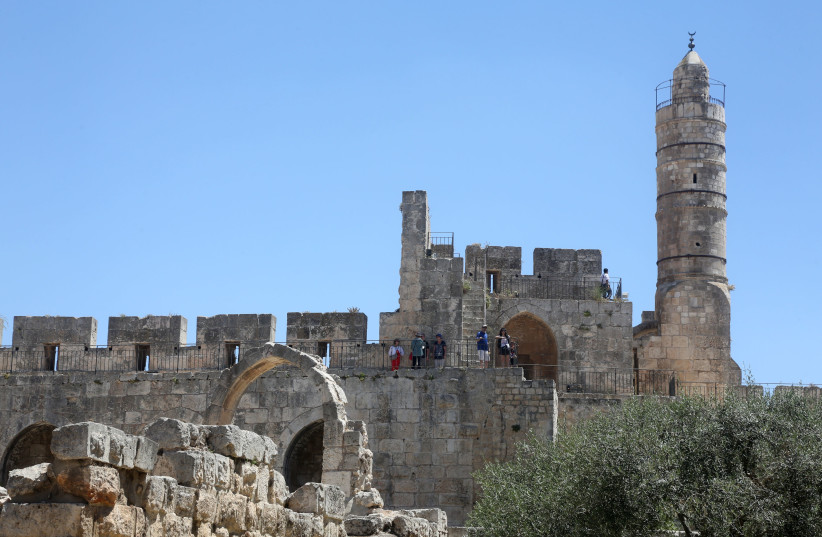The mystery regarding when the Tower of David was built is finally beginning to unravel.
Archaeologists have been excavating deep enough to reach the foundations of the wall, giving experts more information to solve the conundrum over the original dating of the structure.
“We know that the citadel’s wall dates back to the Middle Ages, but scholars have been debating to which period exactly,” said Noam Silverberg, the director of the excavation on behalf of the Israel Antiquities Authority. “In the past, it was believed that the wall was completely erected by the Crusaders; later it was suggested that it was the Mamelukes, at least partially.”
The excavation has been accompanying the construction work for the new pavilion of the Tower of David Museum, whose groundbreaking ceremony took place on Sunday. The structure – set to open in November 2022 – will reach some 17 meters below the level of the citadel and will house the new entrance of the museum, an art exhibition gallery, a café and offices.
The archaeologists were able to collect samples of organic material – and specifically coals – trapped inside the plaster used to build the wall. The samples are being analyzed at the Weizmann Institute of Science.
“This is going to offer us answers not only about this specific area but for many others in the Old City if we see that the plaster used is similar,” Silverberg remarked.
There have been many other revelations as the excavations have progressed. Imagine a few centuries ago, an Ottoman soldier as he walks along Jerusalem’s city wall. Perhaps it was a long and windy winter night, perhaps a summer day, right after dawn. As he looked outside the city to scan the horizon, in a moment of distraction, he dropped the tobacco pipe he was smoking to while away the long hours of patrol.
Many years later, that tobacco pipe, along with some pottery fragments dating back to the time of the 8th century BCE biblical King Hezekiah, was among the artifacts unearthed in the excavation accompanying the construction work for the new pavilion.
The renovation project at the museum will also include a new permanent exhibition presenting the history of Jerusalem through millennia-old artifacts as well as pioneering technology.
In the meantime, the construction works by Jaffa Gate are already offering some unique opportunities to dig into the city’s archaeological mysteries.

In Israel, by law, any development project must be preceded or accompanied by an archaeological excavation.
In Jerusalem, and especially in an area so rich in history as the grounds adjacent to the Old City, the opportunity to dig is very unique, Silverberg said.
“In the past year and a half, we have had the chance to go below the modern floor and to expose many archaeological elements,” he said. “This is truly a once-in-a-generation occasion.”
The area had been excavated by British archaeologist Cedric Norman Johns in the 1920s, who kept a diary and documented some of his finds in pictures. The material helped both the archaeologists and the architects to plan the work.
Yet, many new elements were discovered, including artifacts, a stone bearing an Arabic inscription and a date – 1212 – and a medieval latrine.
IN DESIGNING the new building, preserving the landscape of the area has been a top priority, according to architect Etan Kimmel from Kimmel Eshkolot Architects, which has been tasked with the project.
“It has required five years of design work,” he noted.
“It was important that the new pavilion would blend into the landscape but at the same time did not appear hidden into it, pretending to be ancient when it is modern.”
The result, he stressed, is a very contemporary structure that will welcome visitors coming from the Mamilla area while fitting into the surroundings, “like poetry between old and new,” he noted.
As construction began, the architects have had to constantly consult with the archeologists.
“In such a sensitive spot, you cannot just come up with a big engineering solution without considering what is buried underneath,” Kimmel said.
Asked how often they needed to change plans in light of archaeological needs, he answered “every day.”
The sunken steel, stone and glass Patrick and Lina Drahi Entrance Pavilion is set to be ready in about a year, just after the Tower of David Museum also inaugurates its new permanent exhibition.
“After over three decades, it was about time for a renewal,” said Eilat Lieber, director and chief curator of the museum. “For us it was important not only to renovate the exhibition, but also to add the infrastructure necessary to engage the new generations.”
“The pandemic has presented us with many challenges, but on the other hand has allowed us to accelerate the work,” she noted. “Now we want to be ready to welcome back the tourists, who we are sure will soon come back.”
